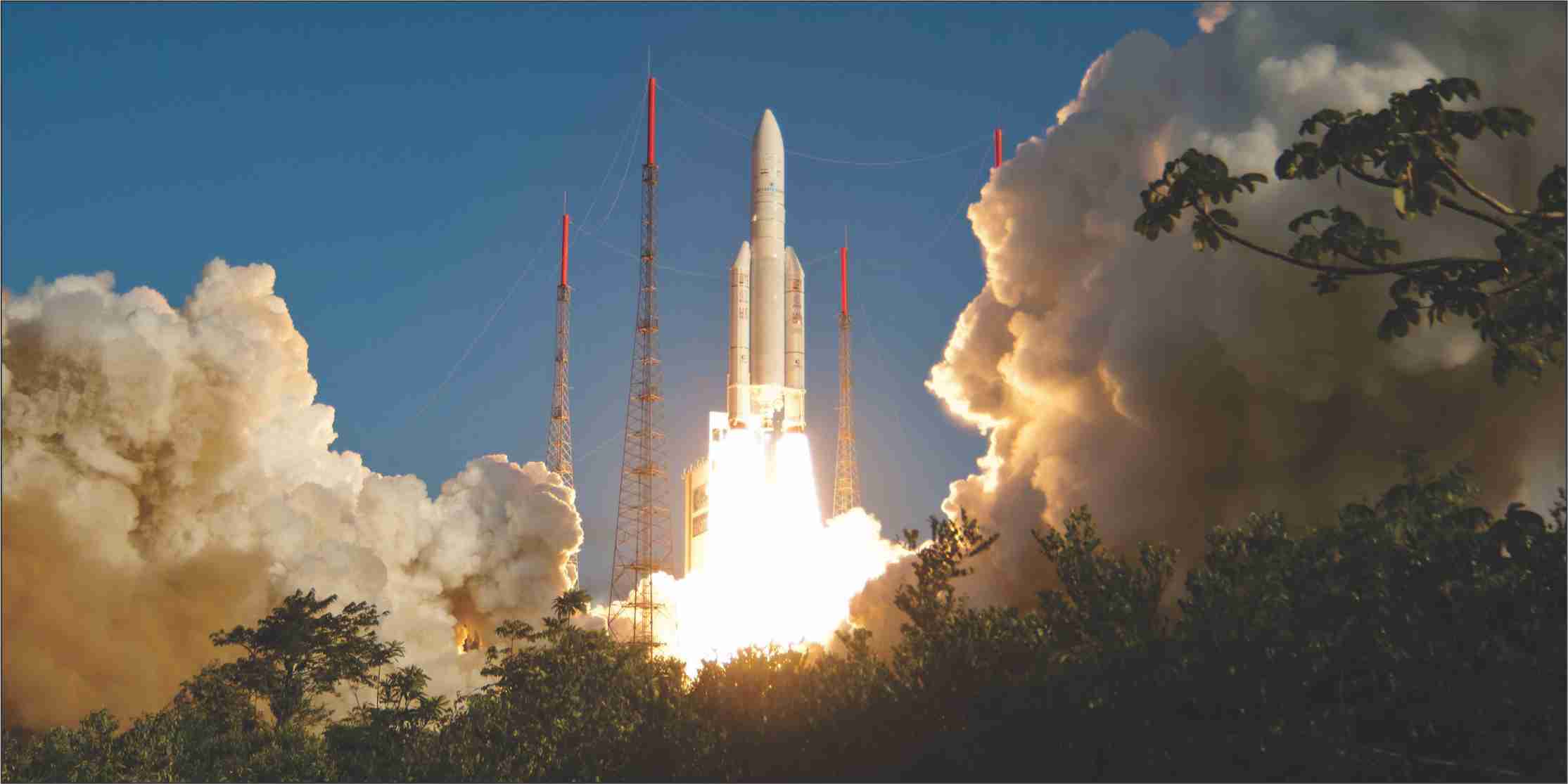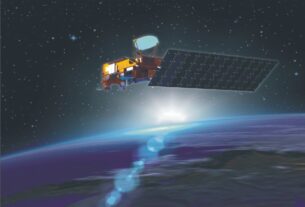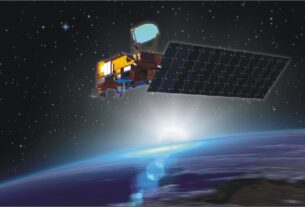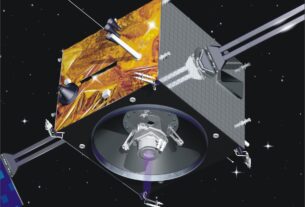In a landmark development of significance to the national security, India’s first ever dedicated defence satellite, GSAT-7 also known as Rukmini, meant for the exclusive use of the Indian Navy has been fully integrated into the network centric operations designed to boost the defence and offensive capabilities in all their manifestations.
For the Indian Navy, the youngest of the three services, GSAT-7 state of the art, an advanced communication spacecraft designed and developed by the Indian Space Research Organisation (ISRO) and launched in August last by means of the Araine-5 vehicle of the European space transportation company Arianespace, multi band space platform will be a major “game changer” and “force multiplier”.
Featuring UHF, S, Ku and C band transponders, the GSAT-7 with a lift off mass of 2625-kg is designed to provide secure, reliable and versatile communications services for the Indian Navy. As it is, the payload configuration of GSAT-7 has been designed specifically to provide high fidelity protected communications over a wide oceanic swath and the Indian landmass.
There is no denying the point that with a high performance communication satellite at its command, the Indian Navy would be in a position to enhance its situational awareness and intelligence gathering capability over the Indian Ocean region where China has stepped up its activities as a counterpoise to the Indian naval build up. Further, with GSAT-7 in operational trim, Indian Navy will be able to overcome the limitations of the line of sight and ionospheric effects normally associated with the conventional communication devices.
With a view to boost its striking punch and expand its area of influence, Indian Navy has implemented a well conceived strategy to link up its long range missiles, radars and air defence systems on all the sea based assets to a central room through the highly reliable communications network provided by GSAT-7.
Strong network
The synergy between the combat platforms moving in the high seas of the world with land based nodes through GSAT-7 capability would help bring about a radical shift in the operational strategy of the Indian Navy. The reliable and robust communications networking capability of GSAT-7 will help Indian Navy expand its security mechanism over a wide swath of both the eastern and western flanks of oceanic expanse.
Indeed, for more than a decade now, Indian Navy has been clamouring for such an advanced space platform with a view to refine and strengthen its “sensor to shooter loop” which implies an ability to swiftly detect and tackle a threat. Indeed, the robust communication potentials of GSAT-7 will help the Indian Navy get a digital tactical battlefield view of the dispersed fleet formations, aircraft locations and even submarines moving stealthily in the depths of the oceans. The long term vision of the Indian Navy is to strengthen its network centric capability by a substantial extent by acquiring a string of satellites meant for a variety of uses including navigation, ocean watch, weather monitoring and electronic ferreting.
A key pre requisite of a networked system is the sustenance of interoperability of the system and real time sharing of information made available by the satellite constellations. Indian Navy can also leverage the potentials of India’s advanced ocean watch satellite Oceansat-II launched in September 2009 and the capabilities of India’s home-grown regional navigation satellite system to expand the frontiers of its network centric operations in a phased and systematic manner.
GSAT-7 marks a small step towards navy’s strategy of transforming itself into satellite augmented network centric three dimensional blue water maritime force. The total dependence of the Indian Navy -prior to the GSAT-7 launch-on the INMARSAT satellite capability available on commercial terms did raise serious questions over the security implications associated with the use of a foreign owned satellite. For the leased satellite capability has its own pitfalls and shortcomings. Indeed, safer communications can be ensured only through home grown space platforms.
Incidentally, there have instances of data bases on leased satellites being compromised. For instance, sometime back, Indian intelligence agencies had warned the Home Ministry that relying on the leased capability of a foreign capability could make critical data base vulnerable to eavesdropping.
Space platform
Interestingly, the futuristic communications satellites designed for the use of Indian defence forces will make an enhanced use of Ka-band frequency to ensure security and provide a greater bandwidth. Use of higher frequency bands including Ka and X makes for an enhanced security of a satellite communications system.
Moreover, high fidelity defence satellites should have an in-built mechanism to automatically and rapidly recover from signal blockages, due to man made objects, terrain conditions including towering mountain ranges, foliage, and weather and associated environmental phenomenon. To acquire expertise in satellite based Ka band communications technology, ISRO is planning an advanced communications space platform featuring 32 Ku band user beams with corresponding gateway links operating in Ka band. This satellite designated GSAT-11 is planned to be launched during 2014-15 timeframe.
By all means, satellite communications cannot be construed as a “safe and secure” operation. For satellites are vulnerable to jamming by hostile forces including terrorists and adversaries. Of course, efforts are on to develop secure, jam resistant satellite communications systems through a variety of innovations.
Interestingly, a number of techniques designed to interfere with or intercept satellite signals are already in use. As such, protection against signal interception and signal degradation clearly underpins the need for radically reconfiguring the satellite design and architecture in terms of transmission, propulsion and encoding technologies.
Incidentally, way back in 2010, there was a speculation that India’s communications satellite INSAT-4B was paralysed by the malicious Stuxnet internet worm. However ISRO made it clear that the failure of the satellite was due to the “power supply anomaly”, thereby implying that Stuxnet had no role to play in the satellite failure. Of course, there have been instances of Stuxnet worm striking a satellite’s programme logic controller.
The Protected Communications Division of MILSATCOM(Military Satellite Communications) forming part of the American Air Force and Missile Systems Centre focuses on the development for US defence forces, survivable, globally secure and jam resistant satellite communications systems for high priority ground, sea and air assets. One of the strategies adopted by MILSATCOM to ensure secure communications is the use of higher frequencies which are difficult to jam.
Similarly, the Milstar satellite communications programme managed by the space command of US Air Force has been described as the tactical and strategic multi service space platforms designed to provide survivable communications for the US defence forces spread across the world. Meanwhile, in a development of significance, satellite communications experts at Raytheon are working on building a jam resistant satellite communications system.
There is certainly no denying the point that a secure satellite communications system is vital for staying at the winning edge of the battlefield. By all means, the safety and security of information made available by satellites should be ensured to avoid the possibility of interception by adversaries. For denial of access to satellite information could be an invitation to a certain defeat in the battlefield operations.
Satellites for NCW
Satellites can serve as a critical components of a network centric warfare which relies on the smartness with which the information superhighway and communications channels are exploited for real time coordination of the “strategic moves” of defence forces spread across and around the world-on land as well as oceanic and air borne platforms.
A satellite based network centric approach helps derive advantages in terms of the ability to stay ahead of an opponent and dictate the dynamics of engagement. By all means, satellites hold the key for a well coordinated and synchronized operations of a battlefield strategy by seamlessly integrating weapons systems, missiles, radars and sensor suits, UAVs, UCAVs, electronics and communications network, fighter jets, transport aircraft, logistics and support systems and defence forces spread across a vast geographical swathe for sustaining “strategic superiority “from the word go. Denying the adversary access to space through the degradation or destruction of his satellite resources has now assumed more usual importance in the modern day warfare strategy.
Navigation satellites have today emerged as vital space platforms with immense potentials to support the network centric operations of all the three wings of the services. A large, independent navigation capability that can be accessed anytime from anywhere holds the key to the success of network centric operations.
Indeed, the US led allied forces during their operations in both Afghanistan and Iraq relied heavily on satellite based navigation with hand held GPS portable devices to meet their strategic goals speedily and efficiently. Prior to that the stunning effectiveness of the American GPS constellation was demonstrated during the “Desert Storm” operations of 1990-91 that was aimed at freeing Kuwait from the clutches of invading forces from the neighbouring Iraq.
The US defence forces have successfully used the GPS capability to guide bombers to targets, help infantry and armoured units to locate their bases in frightening, featureless expanse of the desert and position artillery in a war zone ideally suited to fire at enemy lines apart from precisely navigating missiles to chosen targets. However with the GPS satellites communication being vulnerable to jamming, serious efforts are on to harden the operations of GPS against natural and human interference. A range of jammers to disrupt or degrade the signals emanating from GPS satellites can easily be procured. Indeed, terrorist groups across the world are into the game of jamming GPS signals with a view to stay ahead of the security agencies.
GPS capability is also vital for the firing of missiles and precision weapons with a high degree of accuracy. Under an agreement India has signed with Russia, Indian defence forces will be allowed access to the potentials of the Russian Glonass satellite system for purposes such as firing of a missile with a high degree of accuracy. Indeed, the difficulties India experienced in accessing the restricted services of US owned GPS especially for military applications like firing of the missiles underlines the strategic importance of owning and operating an independent satellite navigation system.
Indigenous system
Fortunately, for the Indian defence forces, the capability of India’s home grown navigation satellite system IRNSS (Indian Regional Navigation Satellite System), will be of immense use in refining the network centric architecture.
Two of the seven satellites constituting the space segment of IRNSS constellation are already in operation. Everything going as planned, the full blown IRNSS constellation will be in place in a couple of years from now. Incidentally, all the seven satellites in IRNSS constellation will have continuous radio visibility with the Indian control station and will transmit ranging signals using codes and data in S and L5 bands.
According to sources in ISRO, the IRNSS is designed to provide accurate position information services to users in India as well as the region extending upto 1500-km from its boundary which is its primary service area. For the Indian defence forces round the clock, all weather access to IRNSS capability will help locate objects in the dark besides paving way for the coordination of troop movement even in hitherto unfamiliar territory in addition to facilitating reconnaissance as well as search and rescue operations.
The intelligence failure experienced by the Indian defence forces before and during the 1999 short lived Kargil skirmish with Pakistan is traced to the lack of access to satellites providing navigation and intelligence gathering services. Meanwhile, ISRO has hinted that depending upon the developments in future, the seven satellite configuration of IRNSS will be augmented with more spacecraft that would ultimately help expand the service areas of IRNSS constellation.
The proposal for India’s tri service aerospace command, which is yet to be cleared by the Indian Government, underpins the need for the creation of a large pool of satellites providing safe and reliable services in areas such as communication, surveillance, navigation, ocean watch and weather monitoring. The network battlefield capability of the tri service aerospace command could be boosted considerably by the imaginative exploitation of satellite resources.
Indeed for a highly effective network strategy, a variety of satellites providing services such as reconnaissance and surveillance, navigation and communications, ocean watch and weather monitoring, signal intelligence and communications intelligence should be in an operational trim on round the clock basis.
Meanwhile, the GSAT-7A satellite, which would be a follow on to GSAT-7 spacecraft, will serve an exclusive space platform of the Indian Air Force (IAF) to help it complete network centric architecture meant to enhance situational awareness and strike capability. However, the firm launch date of GSAT-7A has not yet been announced. By all means, a network centric environment with a constellation of communications satellite at its heart is crucial to boost the capability and stealth of IAF in the thick of a battlefield. Network centricity is equally important to enhance command and control which facilitates an effective and accurate decision making process.
As it is, a significant portion of Global Information Grid (GIG)-the network backbone of US defence set up-relies heavily on space based assets to support the global operations of US military. The basic components of a network centric configuration revolves around improved information sharing through a robustly networked force, enhanced quality of shared information and collaboration and self synchronisation through shared situational awareness. The real time, round the clock information transmission capability of a constellation of satellites meant for a range of applications ultimately dictates the successful implementation of a network centric strategy.





